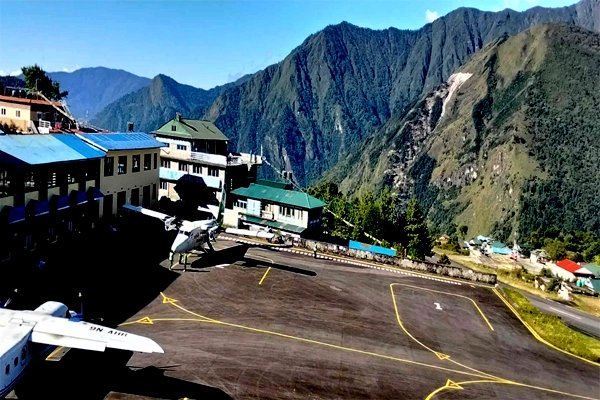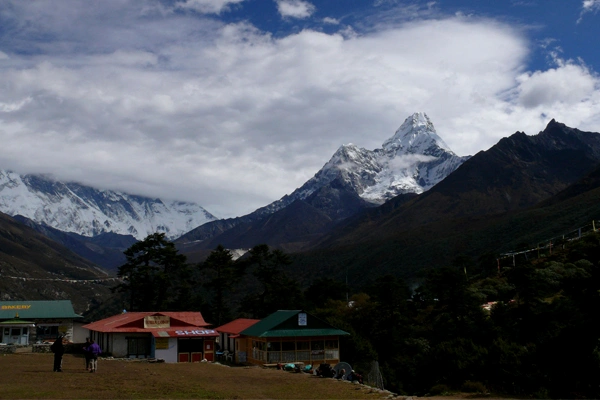Nestled amidst the breathtaking landscapes of Nepal in Sagarmatha National Park, the Everest Base Camp stands as a life achievement adventure in the home of the Himalayas.
Similarly, the Sagarmatha National Park has earned the esteemed title of a UNESCO World Heritage Site which makes it worth visiting once in a lifetime.
So, in this blog, we will talk about the importance of permits, Everest Base Camp Trek permits, and how you can obtain those permits.
Understanding the Importance of Everest Base Camp Trek Permits
To trek on the sacred trails of Everest, two main permits hold the key to this Himalayan kingdom - the Khumbu Rural Municipality Permit and the Sagarmatha National Park Entry Permit. These permits act as gatekeepers, allowing you to venture into the heart of this natural wonderland and witness its unmatched grandeur.
By requiring trekkers to obtain these two permits, the authorities can then better monitor and manage the flow of visitors, minimizing the impact on the delicate environment.
Similarly, the revenue generated from Everest Base Camp Trek permit fees is reinvested in conservation efforts, trail maintenance, waste management, and initiatives to protect the park's flora and fauna.
Sustainable Tourism:
Permits also help in promoting sustainable tourism practices. With a controlled number of trekkers entering the region, the local resources, such as accommodation, food, and water, can be managed more responsibly.
This ensures that the communities in the Everest region benefit from tourism without overwhelming their infrastructure and resources.
Safety and Monitoring:
Another benefit of obtaining permits enables authorities to keep track of the number of trekkers in the region at any given time. In case of emergencies or natural disasters, this information is invaluable for search and rescue operations. The Everest Base Camp Trek Card, in particular, aids in visitor safety monitoring and acts as an efficient way to gather essential trekker data.
Supporting Local Communities:
The permit fees contribute directly to the local economy, benefiting the Sherpa communities that call this region home. These funds go towards infrastructure development, education, healthcare, and other community initiatives, fostering sustainable growth and empowerment.
In conclusion, by securing these permits, trekkers not only gain access to one of the world's most remarkable destinations but also actively contribute to its conservation and the well-being of the local communities.
So, as you set foot on this remarkable journey, embrace the responsibility that comes with obtaining these permits and cherish the unique privilege of exploring nature's majestic masterpiece.
Exploring the Khumbu Rural Municipality Permit: An Essential Authorization
The Khumbu Rural Municipality Permit, formerly known as the Trek Card, unlocks the door to an unforgettable adventure. With a simple fee, foreign nationals and SAARC citizens can access the wonders of the Khumbu region for four weeks.
For extended stays, a slight increment in the fee opens up the possibility of immersing oneself in this captivating land for a longer duration.
Importance of Khumbu Rural Municipality Permit:
Issued by the local government of Khumbu, this permit is an essential means of supporting and empowering the rural communities residing in the region.
The revenue generated from the permit fees directly contributes to the development of local infrastructure, education, healthcare, and other social welfare projects, making a positive impact on the lives of the inhabitants.
Cost and Validity:
The Khumbu Rural Municipality Permit comes at a reasonable cost, making it accessible to trekkers from all walks of life. The Khumbu Rural M. permit fee is NPR 2,000 per person for the first four weeks of the trek. For trekkers planning to stay longer, an additional fee of NPR 2,500 per person applies for each subsequent four weeks. Notably, there is no Value Added Tax (VAT) applicable to the permit fees.
Passport Requirement:
To obtain the Khumbu Rural Municipality Permit, trekkers must present a copy of their passport or provide their passport details. This information is essential for the authorities to validate the identity of the trekkers and maintain accurate records of visitors to the region.
Issuance Points:
Trekkers flying directly to Lukla will typically obtain the Khumbu Rural Municipality Permit upon arriving in Lukla itself. The permit-issuing office in Lukla is conveniently located on the trail paths, easing the process for trekkers. However, for those trekking from the alternative routes of Jiri or Salleri, the permit can be obtained at the Sagarmatha National Park Counter in Monjo.
Sagarmatha National Park Entry Permit
Situated in the iconic Everest/Sagarmatha National Park, this permit holds the key to unlocking a world of natural splendor, awe-inspiring peaks, and unforgettable experiences. The entry permit serves as the gateway to this pristine Everest Base Camp, allowing trekkers to immerse themselves in the wonders of nature at its grandest.
Importance of Sagarmatha National Park Permit:
By acquiring the Sagarmatha National Park Entry Permit, trekkers contribute directly to the conservation and preservation of this delicate ecosystem. The funds generated from the permit fees are channeled into park maintenance, wildlife protection, and sustainable tourism initiatives, ensuring the area's ecological integrity for generations to come.
Cost and Validity of Sagarmatha National Park Permit:
The permit fee for the Sagarmatha National Park Entry varies depending on the nationality of the trekkers. For foreign nationals, the cost is NPR 3,000 per person. For citizens of SAARC countries, the fee is NPR 1,500 per person, while Nepali citizens can obtain the permit at a nominal cost of NPR 100. Additionally, a 13% Value Added Tax (VAT) applies to the permit fees.
Free Entry for Children:
One heartening aspect of the permit policy is that children under the age of 10 years are entitled to free entry to the Sagarmatha National Park. This gesture aims to promote family-friendly trekking experiences and nurture a love for nature and adventure from an early age.
Passport Requirement:
To obtain the Sagarmatha National Park Entry Permit, trekkers need to provide a copy of their passport along with their passport details. This essential information aids in maintaining accurate records and ensures the security and safety of trekkers during their journey.
Obtaining the Permit:
Trekkers can acquire the Sagarmatha National Park Entry Permit at the National Park and Wildlife Conservation Department (DNPWC) counter in Bhrikuti Mandap, Kathmandu.
Alternatively, the permit can also be obtained at the entry gate in Monjo, a village en route to Everest Base Camp. While obtaining the permit in Monjo is possible, during peak trekking seasons, it may result in longer waiting times, making it advisable to secure the permit in Kathmandu before commencing the trek.
In conclusion, the Sagarmatha National Park Entry Permit is much more than a piece of paper; it symbolizes the traveler's responsibility to safeguard the Himalayan ecosystem.
With this essential authorization in hand, trekkers can embark on a journey of a lifetime, where every step uncovers nature's grandeur and the indomitable spirit of the world's highest mountains.
Frequently Asked Questions
Is the Khumbu Rural Municipality Permit the same as the Trek Card?
Yes, the Khumbu Rural Municipality Permit replaced the Trek Card in September 2022.
Is there a fee for children under 10 years of age for the Sagarmatha National Park Entry Permit?
No, children under 10 years of age can enter the park for free.
Where can I obtain the Sagarmatha National Park Entry Permit?
- Nepal Tourism Board Office, Pradarshani Marg, Kathmandu 44617.
- Sagarmatha National Park Entry Gate in Monjo.
Should I obtain the permits in Kathmandu or Lukla?
- For the Khumbu Rural Municipality Permit, get it in Lukla if flying, or Monjo if coming from Jiri or Salleri.
- For the Sagarmatha National Park Entry Permit, it is recommended to get it in Kathmandu to avoid long queues during peak trekking seasons.
Conclusion:
In conclusion, Everest Base Camp Trek Permits are not just bureaucratic formalities; they hold immense significance for trekkers venturing into the mystical realm of the Himalayas. The Khumbu Rural Municipality Permit, an essential authorization, welcomes trekkers into the warm embrace of Sherpa culture and mesmerizing landscapes. Its accessibility in Lukla or Monjo ensures a seamless start to the trek, allowing travelers to focus on the journey ahead.
On the other hand, the Sagarmatha National Park Entry Permit acts as a gateway to a natural wonderland, contributing to conservation efforts and sustainable tourism. By securing this permit, adventurers become custodians of the pristine ecosystem, safeguarding it for future generations. Embracing the responsibility, trekkers can cherish the beauty of the Everest region while treading respectfully on its hallowed trails.
Suggested Blogs:
Everest Base Camp Trek Difficulty: “Embarking on the Everest Base Camp Trek is an exhilarating feat, but it comes with its fair share of challenges.”
Best Time to Visit Everest Base Camp: “The Himalayan weather can be unpredictable, and choosing the right time for your Everest Base Camp adventure is crucial.”




